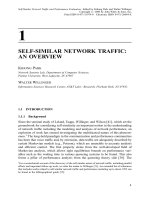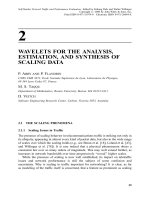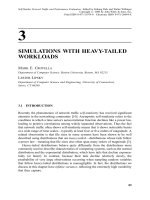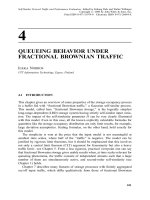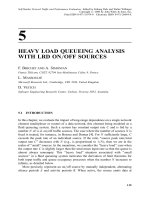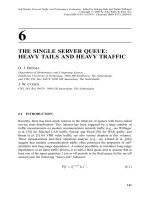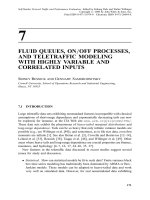Tài liệu Mạng lưới giao thông và đánh giá hiệu suất P11 doc
Bạn đang xem bản rút gọn của tài liệu. Xem và tải ngay bản đầy đủ của tài liệu tại đây (171.62 KB, 16 trang )
11
TRAFFIC AND QUEUEING FROM AN
UNBOUNDED SET OF INDEPENDENT
MEMORYLESS ON=OFF SOURCES
P
HILIPPE
J
ACQUET
INRIA, 78153 Le Chesnay CeÂdex, France
11.1 INTRODUCTION
11.1.1 Long-Term Dependence and Packet Loss in Telecommunication Traf®c
In early literature about the performance of telecommunication systems, traf®c was
generally modeled as memoryless Poisson streams of packets. In these models the
packet arrival processes show no time interdependence. Recent measurements on
Web traf®c show that this hypothesis is wrongand that Web traf®c actually
experiences what we now call long-term dependence.
Long-term dependence is interesting not only because it contradicts Poisson's law,
but also because it signi®cantly impacts the performance of networks. One effect is
that it dramatically increases packet loss in data networks. For example, let us focus
on an Internet router. In a simple model, the router can be seen as a buffer served by
a single server. When the buffer over¯ows, some packets are lost. The lost packets
must be re-sent followingTCP=IP, thus addingextra delay and traf®c.
If we simply model the router by a M=M =1 queue with an in®nite buffer, input
rate l, and service rate 1, then the probability p
n
that the queue length is greater than
n is exactly l
n
. In a ®rst-order approximation, quantity p
n
can be identi®ed with the
packet loss rate in a buffer of size n. Therefore, to keep packet loss below some
acceptable level e, it suf®ces to make the buffer capacity greater than log e=log l),
Self-Similar Network Traf®c and Performance Evaluation, Edited by KihongPark and Walter Willinger
ISBN 0-471-31974-0 Copyright # 2000 by John Wiley & Sons, Inc.
269
Self-Similar Network Traf®c and Performance Evaluation, Edited by KihongPark and Walter Willinger
Copyright # 2000 by John Wiley & Sons, Inc.
Print ISBN 0-471-31974-0 Electronic ISBN 0-471-20644-X
that is, a logarithmic function of 1=e. In general, telecommunication designers work
on e on the order of 10
À6
and l < 0:8.
Long-term dependent traf®c can make loss and retry rates p
n
Bn
Àb
for some
b > 0 [1]. In other words, the queue size distribution has a heavy tail. Under this
condition it is clear that buffer capacity would need to be raised to b=e
1=b
to keep
packet loss rate under the acceptable level e, which no longer leads to a logarithmic
function of 1=e, but to a polynomial function of 1=e. Indeed, this minimal size would
be several orders of magnitude higher than the capacity obtained with the Poisson
model. In fact, actual router capacities are dangerously underestimated with regard
to this new traf®c condition.
11.1.2 Contribution of this Chapter
The Poisson law is the natural consequence of the law of large numbers, best
describes the cumulated effect of several independent, identically distributed (i.i.d)
sources in parallel. Assume, for example, N sources, each of them producingon
average l=N events per time unit accordingto a stationary random process. Then
when N tends to in®nity, the interevent times T tend to be i.i.d with a distribution
function characterizingthe Poisson law,
PrfT > xge
Àlx
: 11:1
The convergence to a Poisson distribution still holds when the sources are not quite
identical, as long as they have similar pro®les. Feller [2] gave pretty general
conditions for this convergence: basically, ®rst moments of the source interevent
generation time must be O1=N and second moments must be o1=N.
In this chapter we are interested in the case where traf®c is created from a large
set of independent sources that do not satisfy Feller's conditions. In particular, we
focus on certain sets of on=off sources that produce long-term dependence when
their sizes tend to in®nity. It will also be shown that queues submitted to such sets
of sources will experience buffer occupation with a polynomially decayingtail
distribution.
In the other chapters of this book it is assumed that some of the sources, taken
individually, already produce long-term dependence. For example, some sources
have heavy-tailed ``on'' periods. In this case the cumulated traf®c shows long-term
dependence and creates a heavy-tailed queue size distribution [3, 4]. The challenge
in the present chapter is that none of the sources, taken separately, produces long-
term dependence and a heavy-tailed queue size distribution, and that those
phenomena eventually take place when the number of sources increases. To insist
on this point, we will focus on individual on=off sources with memoryless pro®les
(exponentially distributed on periods and off periods). It has already been shown by
Beran [5] and Jacquet [6] that such sources can create long-term dependence when
their number increases. The contribution of the present chapter is to show that such
sources can also create a polynomially decayingqueue size distribution. We do not
claim that pure memoryless on=off sources are necessarily realistic models for Web
270
TRAFFIC AND QUEUEING FROM AN UNBOUNDED SET
sources of traf®c, but they have the advantage of being simple and analytically more
tractable than more general models.
Our model stands halfway between the Boxma±Dumas models [7] with ®nite sets
of on=off sources and the very excitingmodel of Tsybakov et al. [8], which assumes
a continuum of on=off sources from which ``on'' periods are activated accordingto a
Poisson process. A last technical point: we don't use ¯uid approximation in this
chapter, although this feature has very interesting aspects.
11.2 TOOLS AND MODELS
11.2.1 The Mellin Transform Applied to Performance Analysis
The technical novelty of this chapter is in the extensive use of the Mellin transform.
The Mellin transform is particularly well adapted to capturingthe polynomial effects
in function asymptotics with an unprecedented accuracy [9]. It has similar features to
those of the Laplace transform, the latter beingknown for more than a century to be
a good tool for capturing exponential effects in functions. The Mellin transform
f *s of a function f x, de®ned for real x > 0, is
f *s
I
0
f xx
sÀ1
dx: 11:2
Note that the Mellin transform of function f x is nothingmore than the Laplace
transform of f e
x
. The Mellin transform is de®ned for s in the fundamental strip
fs; RsPa; bg of function f x. The constants a and b are the lower and upper
bounds of the real numbers c such that f xox
Àc
for both x 3 0 and x 3I.
The fundamental strip of function e
Àx
is fs; Rs > 0g: in other words, a 0,
b I. In passing, the Mellin transform of e
Àx
is the celebrated Euler Gamma
function, denoted Gs. The fundamental strip of any polynomial function is the
empty set: there is no Mellin transform of pure polynomial functions.
The inverse Mellin transform is
f x
1
2ip
ciI
cÀiI
f *sx
Às
ds 11:3
valid for any c contained in the fundamental strip.
The Mellin transform has been introduced primarily to handle harmonic sums. A
harmonic sum of function f x is a series of the followingkind:
P
i!0
a
i
f o
i
x
11.2 TOOLS AND MODELS
271
for some sequences a
i
and o
i
, which make the sum properly convergent. The Mellin
transform of the harmonic sum is
P
i!0
a
i
o
Às
i
!
f *s;
where f *s is the Mellin transform of function f x. This latter expression is
sometimes much easier to handle than the harmonic sum itself.
The analysis of function f x asymptotics, when x tends to both limit 0 and I,is
equivalent to the singularity analysis of the Mellin transform f *s on the boundaries
of its fundamental strip. The right boundary corresponds to the asymptotics when
x 3I; the left boundary corresponds to the asymptotics when x 3 0. For
example, if f *s has one single pole on the right boundary at s b, this pole has
residue m, and function f *s can be extended for ResPb; b e. Then in Eq.
(11.3) the integration line can be moved on the right (see Fig. 11.1).
Applyingthe residue theorem, we ®nd
f xmx
Àb
x
ÀbÀe
2ip
I
ÀI
x
Àit
f b e it dt: 11:4
Using a majorization under the integral sign, we get a second-order estimate:
f xmx
Àb
Ox
ÀbÀe
when x 3I.
The Mellin transform can provide a more accurate estimate and can even capture
the case where the constant before the x
Àb
estimate is a ¯uctuatingfunction of x.
Fig. 11.1 Movement of the integration line in the reverse Mellin transform.
272
TRAFFIC AND QUEUEING FROM AN UNBOUNDED SET
As an illustration, consider the followingfunction f x satisfyingthe functional
equation:
f x
1
2
f x=2e
Àx
=2: 11:5
This equation arises in the analysis of divide and conquer algorithms [10]. The
solution is obtained by iteration:
f x
P
i!0
2
Ài
e
x=2
i
: 11:6
By virtue of the harmonic sum expression, the Mellin transform f *s is immediately
identi®ed by f *s2
À1s
f *sÀGs,or
f *s
Gs
1 À 2
À1s
11:7
for s in the fundamental strip fs; RsPÀ0; 1g. Note that there is a sequence of
single poles 1 2ikp=log2, for k integers, that are all located on the strip
boundary fs; Rs1g. Usingthe reverse Mellin transform and catchingall the
residues of these poles by moving the integration line on the right (see Fig. 11.2), we
get
f xPlog xx
À1
Ox
À1Àe
11:8
with
Py
P
k
G 1
2ikp
log2
exp
2ikpy
log2
: 11:9
Fig. 11.2 Reverse Mellin transform with multiple poles.
11.2 TOOLS AND MODELS
273
It is clear that Px is of period log2 with Fourier coef®cients identi®ed in Eq. (11.9).
To make a more general statement, the Mellin transform is the ideal tool for
capturingthe slowly varyingfunctions in front of polynomial factors. Here the term
analytical information theory is used to describe problems of information theory that
are solved by analytical methods borrowed from complex analysis [11, 12]. Refer to
Szpankowski [12] for a survey and to Jacquet [6] for a detailed description of the
tools and proofs used in the present chapter.
11.2.2 Memoryless On=Off Sources
As mentioned earlier we focus on the simpli®ed case where each source has a
memoryless pro®le. A memoryless on=off source is described by only two statesÐ
the ``on'' state and the ``off'' stateÐand has the followingproperties:
In the ``off'' state, the source does not generate any packet.
In the ``on'' state, the source generates packets as a Poisson stream with
constant rate l.
The transition from the ``on''state to the ``off'' state occurs with constant rate n
0
.
The transition from the ``off'' state to the ``on''state occurs with constant rate n
1
.
Note that the ``on'' periods and ``off'' periods are both exponentially distributed;
that is, the state transition times follow a memoryless process.
We introduce the matrix T, which we call the transition matrix:
T
Àn
1
n
0
n
1
Àn
0
11:10
The eigenvalues of T are 0 and Àn
1
n
0
.
In most of this chapter we consider a general system where the arrival process
comes from several independent memoryless on=off sources. We consider a
denumerable set of on=off sources indexed from 1 to N, N tendingto in®nity in
the analysis. See Fig. 11.3 for an illustration.
11.3 QUEUEING UNDER ON=OFF SOURCES
In the following, the network is modeled via several queues with single servers and
an in®nite buffer, which receive input from a set of on=off sources. The service time
at each queue is exponential. Our aim is to ®nd the steady-state distribution of the
queue length and, in particular, the asymptotics of the probabilities p
n
that the queue
length exceeds n customers, when n 3I.
274
TRAFFIC AND QUEUEING FROM AN UNBOUNDED SET

